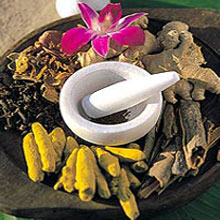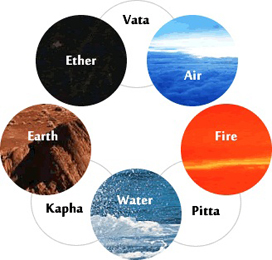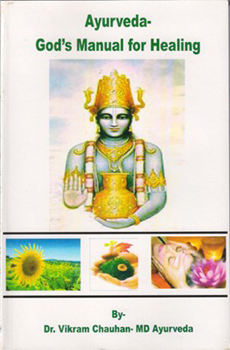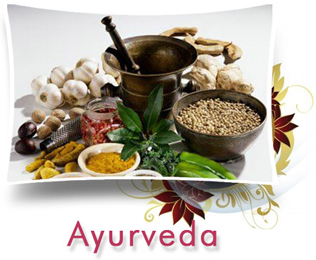
Overview
Ayurveda is the traditional medicine of India, which originated there over 5,000 years ago. Ayurvedic medicine emphasizes re-establishing balance in the body through diet, lifestyle, exercise, and body cleansing, and on the health of the mind, body, and spirit. In North America, Ayurveda is considered a form of alternative medicine. Like traditional Chinese medicine, Ayurveda is a whole medical system, meaning that it is based on theories of health and illness and on methods of preventing and treating health conditions.
It is a very substantial compilation of some incredible herbal “jadibutis” or herbs and processes which can care or prevent any kind of maladies or ailments in human body or mind system. Old is not just gold here, instead it seeks and means life here. Derived from thousands of years of research, experimentation and actual-proofs, Ayurveda stands upright in the triumphant world of medical science. Ayurvedic herbal products are an outcome of the same; the centuries of well being and successful cures for most serious of disorders and problems of the body and the psyche. Natural procedures are always better than the artificial ones, and that is the strongest pillar that supports the Ayurvedic herbal world; it is so innate and natural so that it heals from the root that too without any side effects.
Ayurveda is stranded in metaphysics of “five great elements” and this are- Prithvi-earth, Aap-water, Tej-fire, Vaayu-air and Akash-ether. All of which compose the Universe, including the human body. Ayurvedic medicine deals ornately with measures of healthy living during the entire span of life and its various phases. Ayurveda deals with Doshas (avguns) or shortcomings, these are important for health, because when they are in balanced state, the body is healthy and when imbalanced, the body has diseases. The imbalanced state is thus that problematic stage which is mended by the naturopathy of ayurvedic herbal products and that too without any side effects or the ills of the other strong and artificial systems of medication. Just like Doshas, the human body perceives attributes of experiences as 20 Gunas meaning qualities. It is supposed that maintaining as well as building a healthy metabolic system, attaining good digestion, and proper excretion leads to vitality. In Ayurveda, doshas account for some of our individual differences.


Ayurveda – God’s Manual for Healing
An Excellent Introductory Book on Ayurveda for Beginners
This book is an excellent introductory book which explains the basic concepts of Ayurveda and its healing abilities. The basic concepts of ayurvedic medicine are explained in a very comprehensive and simple language. The vata dosha is a combination of space and air. It controls movement and is responsible for basic body processes such as breathing, cell division and circulation.
Vata body areas are the large intestine, pelvis, bones, skin, ears, and thighs. People with vata as their main dosha are believed to be quick-thinking, thin, and fast, and are susceptible to anxiety, dry skin, and constipation.
The kapha dosha represents the elements of water and earth. Kapha is believed to be responsible for strength, immunity, and growth. Kapha body areas are the chest, lungs, and spinal fluid. People with kapha as their main dosha are thought to be calm, have a solid body frame, and are susceptible to diabetes, obesity, sinus congestion, and gallbladder problems.
The pitta dosha combines fire and water. It is thought to control hormones and the digestive system. Pitta body areas are the small intestines, stomach, sweat glands, skin, blood, and eyes. People with pitta as their primary dosha are thought to have a fiery personality, oily skin, and are susceptible to heart disease, stomach ulcers, inflammation, heartburn, and arthritis. Ayurveda thus focuses on herbal medication, yoga, meditation and massage.
To buy this book, please visit store.planetayurveda.com/products/dr-vikram-chauhan-book
Some of the basic herbal medications and Ayurvedic medicines provided by us are herbs powders, herbal capsules in vegetarian capsule shells, herbal juices, herbal tablets, herbal classical ayurvedic medicines.
For example we provide Ashwagandha, Tulsi, Guggul, Musli, Asparagus, Tribulus, Nut-meg, Valerian, Jatamansi, Brahmi, Amla juice, Shilajit, Curcumin, Arjuna, Arjun tea, Detox tea, Hakam Churna, Weight Gain formula, Trim Support for Weight loss, Garcinia, Bramhi Chawyanprash, Aloe vera juice, Datura, Arogyavardhni, Methi, Haldi, and thousands of such exceptional and distinctive natural gifts. The assortments as well as individuality of all these innumerable Ayurvedic medicines is not just beneficial but life saving also.
Ayurveda – A Time Tested Medical Science
What has to exist, exists, no matter what way the world changes. Any science, that is applicable survives through different generations and flows from one generation to another. Nature has its unique way to make or break a system, and we remain just an onlooker, erased by the passage of time! So Ayurveda is a science which has faced the turmoil of all times and is still emerging as a leading alternative health care system. Ayurveda is the world’s oldest science of health care. The written tradition dates back around 5,000 years, but the oral tradition of this science is timeless.

The Basic Principles of Ayurveda
There are three basic fundamental biological humours described by Ayurveda – The Vata, Pitta and Kapha also called the “tri-energies”. These are the ones who are totally controlling the universe and are responsible for planetary movements (Vata), their formation and destruction ( Pitta) and generation and maintenance of new life (Kapha). Same tri-energies are found inside every living being and are responsible for health and disease. Their balance is health or harmony whereas the imbalance is disease or chaos.
These govern all the processes in all levels of our life. Vata governs all movement, Pitta all heat and transformation and Kapha all growth, structure and lubrication.
Our diet, our behavior, the seasons, emotions and our life style all have impact on balance of trienergies. The main principal of healing in Ayurveda is to maintain the balance of Vata, Pitta and Kapha by alteration in our lifestyle, our thoughts, our diet and understanding nature and through herbal medicines.
Samadosha samagnisch samadhatu malakriya
Prasanna atma mana swastha iti abhidhiyate. (Sanskrit Verse)
It States That: –
Having a balanced state of Doshas, Agni (Digestive Fire), Dhatus (tissues) and normal functioning of Mala (waste products), cheerful state of Atman (soul), sensory organs, and mind are the symptoms of healthy life.
- If Vata gets out of balance, for instance, it leads to overactive mind, poor circulation, poor nerve conduction, loss of memory, irregular elimination, uncomfortable menses, etc. – all things related to movement.
- If Pitta is out of balance, we can get excessive digestive fire, resulting in heartburn, excess stomach acid, a hot temper, inflammations, etc. -all things related to heat and digestion.
- If Kapha gets out of balance, it can lead to chronic congestion, weight gain, cellulite, cholesterol buildup, acne, oily skin, etc. – all things related to structure and lubrication.
Herbs in synergistic combination, diet, routine, meditation, etc. are used to restore balance to restore proper operation of the various systems. Balance restores health. Ayurveda does not focus on decreasing symptoms, it focuses on increasing health. Where there is health, there is no room for disease.
Due to foreign invasions in India for hundreds of years, Ayurveda became fragmented, and it on its come back trail from around last 35 years. As a result of growing scientific verification at major research institutions, it is the worlds’ fastest growing health care system.
According to Ayurveda, the five elements (fire, earth, water, air & space) in their biological form combine to form these 3 energies in the body. These 3 basic energies are the primary life forces or biological humors, called doshas in Ayurveda – The Vata, Pitta and Kapha. They help regulate physical functioning within our body, besides providing us with individual physical characteristics. The constitution of a person is primarily determined by the dominant dosha .
It is such a unique combinations of doshas that no two persons are alike. The determination of the constitution gives insight into deeper working, behavior, body type and with this it is possible to know which herbs, diet, medicines and activities will be suitable for a particular individual to maintain his health whole life. It also becomes easier to outline the disease tendencies of the different body types so that a preventive lifestyle may be observed. Accordingly, a person can plan diet and other routine activities affirming to his / her constitution. This individual constitution analysis is an important step to ascertain about types of diseases and to help a lot in maintenance of good health and prevention of diseases.
Your predominant dosha could be any one of the three, a combination of any two or all the three in a balanced form.
Vata | Vata-Pitta | |
Pitta | Vata-Pitta-Kapha | Vata-Kapha |
Kapha | Pitta-Kapha |
Click here to Know your body type (Prakriti analysis).
